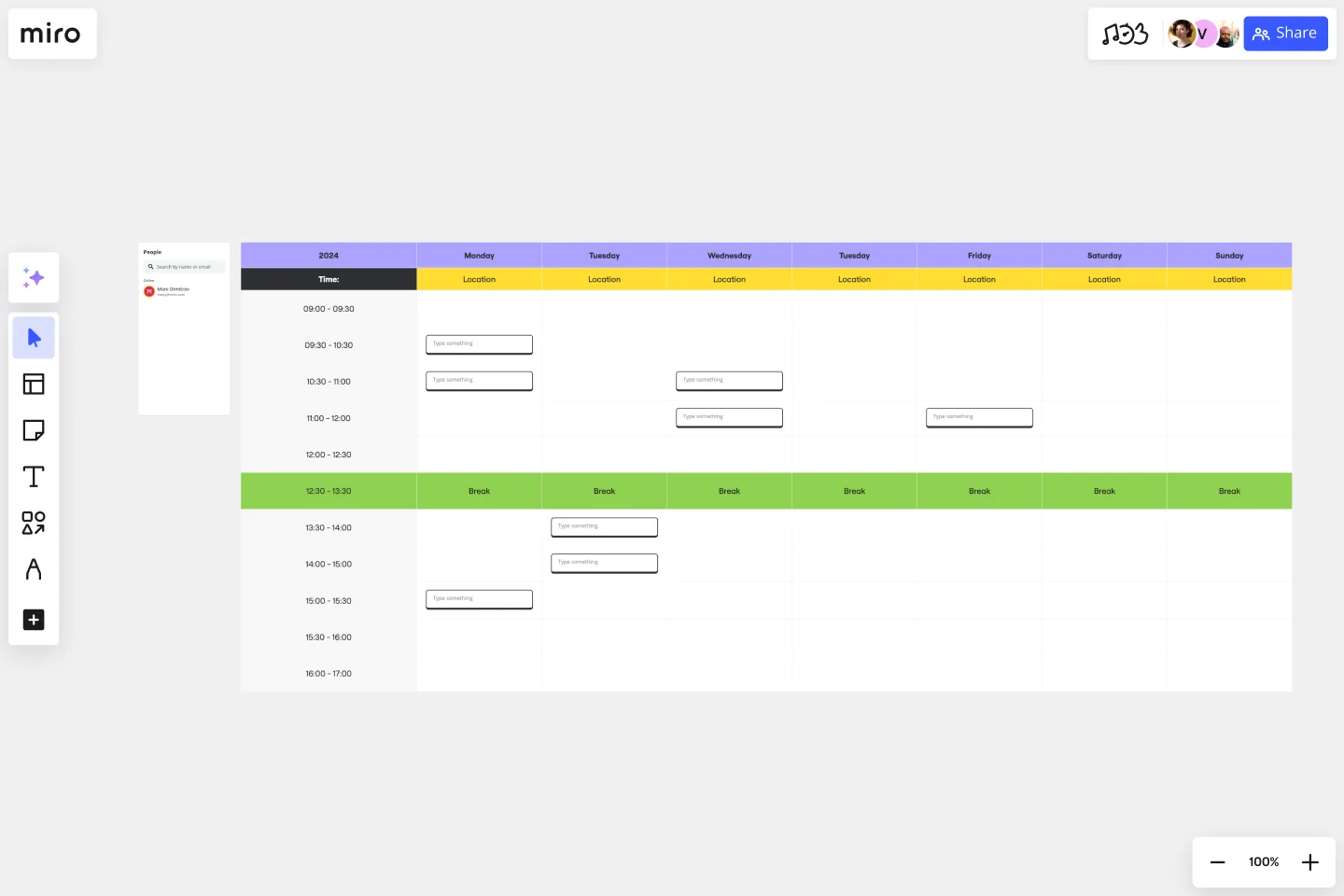Weekly Schedule Template
Unlock productivity with the weekly schedule template. Effortless planning for a well-structured week.
About the Weekly Schedule Template
The Weekly Schedule Template is a useful tool for improving time management skills. This template helps you plan and organize your week in a well-structured and efficient manner. It provides a detailed overview of your weekly activities, tasks, and events in a visual format, helping you prioritize your goals and commitments quickly.
With this template, you can plan your week, allocate your time and resources appropriately, and ensure you stay on track to achieve your objectives. So, if you're seeking a dependable and effective way to manage your time, the Weekly Schedule Template is an ideal partner for you.
How to use the weekly schedule template
Access the template: Locate the Weekly Schedule Template in the template section of your platform.
Edit weekly slots: Click on specific time slots to adjust durations or rename activities based on your weekly priorities.
Customize timeframes: Modify the overall timeframe to suit your planning preferences, whether viewing your entire week or specific days.
Input events and tasks: Add events, meetings, or tasks by clicking on the relevant slots, ensuring a comprehensive overview of your week.
Enhance with artifacts: Elevate your schedule by incorporating artifacts from your board, such as links, images, or other visual aids.
Color-code for clarity: Use color-coded labels to distinguish between work, personal, or other categories, enhancing visual clarity.
Save and share: Once your weekly schedule is refined, save it and share it effortlessly for collaborative planning and alignment.
Why should you use the weekly schedule template?
Structured planning: Organize your week in advance, providing a clear roadmap for daily activities.
Time optimization: Allocate time efficiently, ensuring a balanced distribution of tasks and responsibilities.
Prioritization: Identify and prioritize essential tasks, preventing overwhelm and promoting focus.
Goal alignment: Align your weekly schedule with broader goals, enhancing long-term productivity.
Visualization: Gain a holistic view of your week, facilitating better decision-making and time allocation.
Can I adjust the daily time intervals on the template?
Certainly. The template is designed to be flexible, allowing users to customize daily intervals per their preferences.
Is there an option for recurring tasks?
Yes, easily duplicate or replicate events to indicate recurring tasks, simplifying the scheduling process.
How can I visualize my entire week quickly?
Adjust the overall timeframe with a few clicks to instantly visualize your entire week at a glance.
Can I color-code different days for better distinction?
While the template allows for individual day customization, users can implement color-coding for quick and clear differentiation between days.
Get started with this template right now.
Pros and Cons List Template
Works best for:
Decision Making, Documentation, Strategic Planning
A pros and cons list is a simple but powerful decision-making tool used to help understand both sides of an argument. Pros are listed as arguments in favor of making a particular decision or action. Cons are listed arguments against it. By creating a list that details both sides of the argument, it becomes easier to visualize the potential impact of your decision. To make your pros and cons list even more objective, it can help to weight each pro and con against the others. You can then present your decision with confidence, making a strong argument for why it’s the right one.
Design Brief Template
Works best for:
Design, Marketing, UX Design
For a design to be successful, let alone to be great, design agencies and teams have to know the project’s goals, timelines, budget, and scope. In other words, design takes a strategic process—and that starts with a design brief. This helpful template will empower you to create a brief that builds alignment and clear communication between your business and your design agency. It’s the foundation of any creative project, and a single source of truth that teams can refer to all along the way.
Cone Roadmap
Works best for:
Roadmap, Planning, Mapping
The Cone Roadmap template offers a visual representation of project timelines and dependencies, with a focus on narrowing scope over time. By starting with broad initiatives and gradually refining them into actionable tasks, teams can manage complexity and ensure alignment with strategic goals. This template promotes transparency and adaptability, empowering teams to respond effectively to changing priorities and market dynamics.
Product Development Roadmap Template
Works best for:
Product Management, Software Development
Product development roadmaps cover everything your team needs to achieve when delivering a product from concept to market launch. Your product development roadmap is also a team alignment tool that offers guidance and leadership to help your team focus on balancing product innovation and meeting your customer’s needs. Investing time in creating a roadmap focused on your product development phases helps your team communicate a vision to business leaders, designers, developers, project managers, marketers, and anyone else who influences meeting team goals.
Scope of Work Template
Works best for:
Project management, Planning
The Scope of Work Template from Miro brings structure, clarity, and efficiency to project planning. It's more than just a template—it's an adaptable and dynamic platform that adapts to your unique project needs. Join thousands of satisfied users and make the Scope of Work Template a part of your project management toolkit.
Product Ops Canvas
Works best for:
Product Management, Planning
The Product Ops Canvas template helps product managers align product strategies with operational capabilities. By mapping out key operational processes, tools, and metrics, this template fosters alignment between product and operational teams. With sections for identifying bottlenecks and optimizing workflows, it supports continuous improvement in product operations. This template serves as a guide for driving efficiency and scalability in product management processes, enabling teams to deliver high-quality products at scale.
